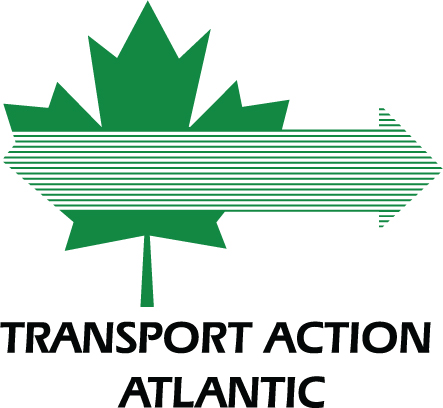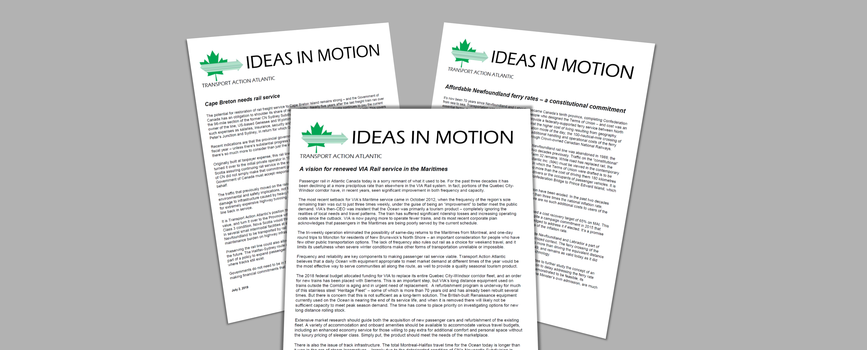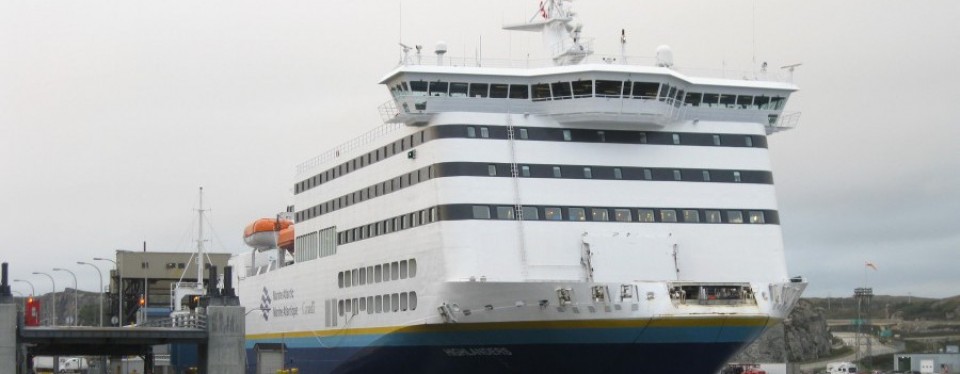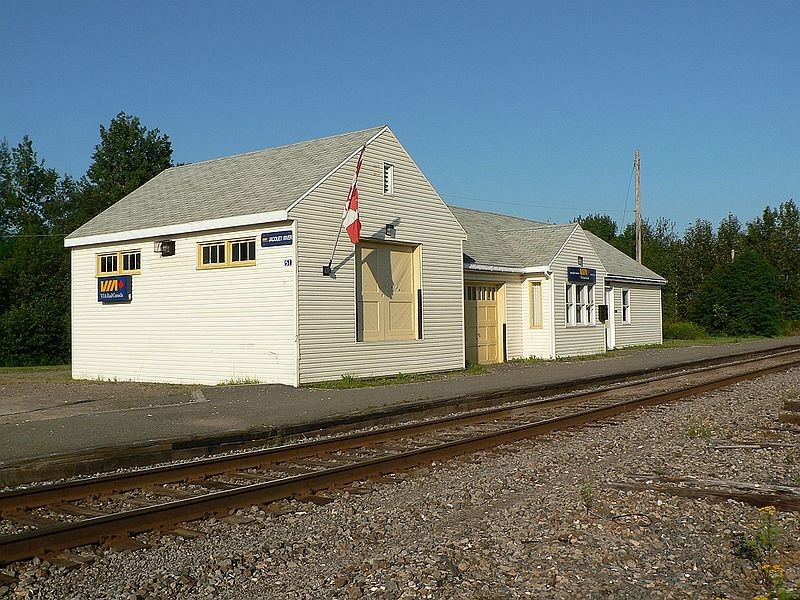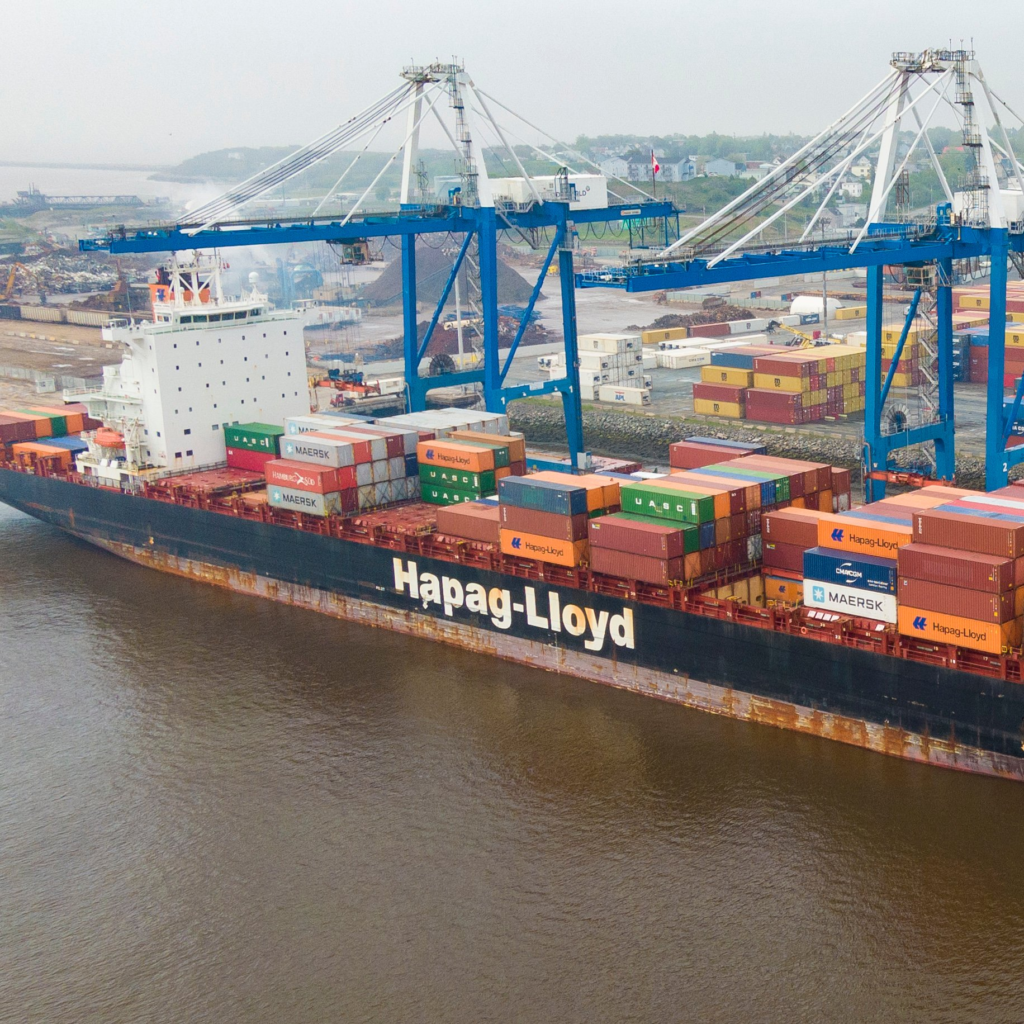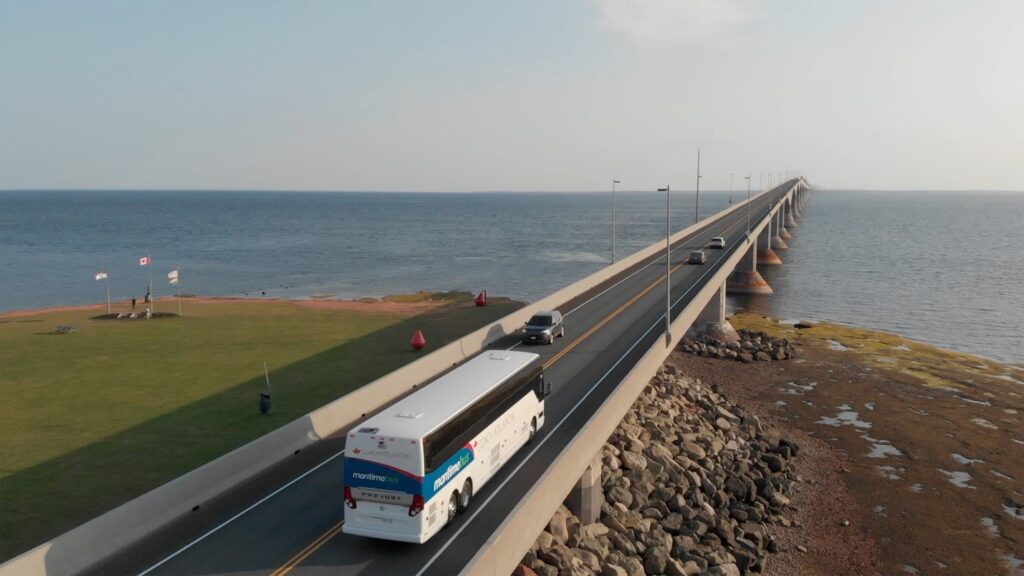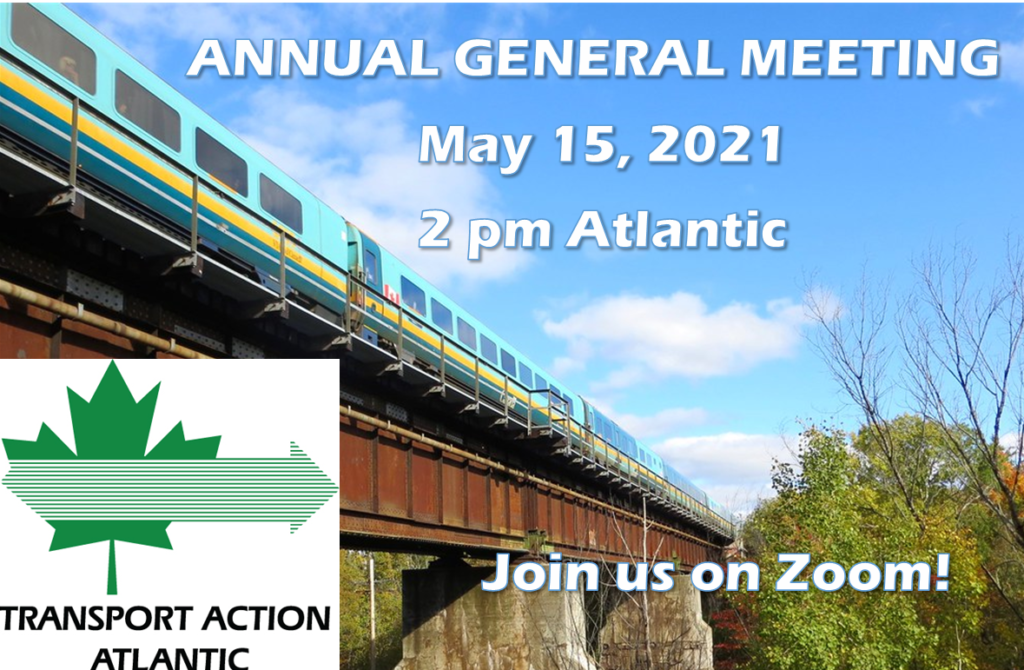Welcome to the July edition of Atlantic Transport News!
Here’s a look at what you’ll find in this edition:
- Electric Ferries planned for Halifax
- Atlantic Bubble off to a shaky start
- VIA Rail Ocean service finally set to resume in August
- A different summer at Marine Atlantic
- Maritime Bus starts six day operation, DRL soldiers on
- Shuttered airports re-open, with some new service
- New rural and small town transit projects underway
- Nova Scotia removes fares from intra-provincial ferries
ELECTRIC FERRIES PLANNED FOR HRM

Halifax Transit has received a major boost to one of their rapid transit plans, as all levels of government have stepped in with funding to move ahead with a plan to launch a fast, electrified ferry service from Bedford into downtown Halifax. Halifax Transit had announced the plan as part of their Rapid Transit Strategy, and in June the federal, provincial and municipal governments announced funding support to move the project toward becoming reality.
The full project, which will involve the construction of new ferry terminals, replacement of the downtown Halifax terminal, and the purchase of new vessels for the service, is estimated to cost $134.5 million. An initial $3.3 million study to plan and engineer the service will be supported by $1.1 million from the province of Nova Scotia, $1.3 million from the federal government, and another $917,000 from the Halifax Regional Municipality. This phase of the project is expected to be complete in 2022, with hopes that the ferry service will be able to launch in 2024.
In a separate announcement, the HRM announced a tender for design concepts for the rebuild of the downtown terminal and the design of the new Mill Cove terminal. The downtown terminal will need to be expanded significantly to accommodate the new electric vessels planned for the service, and the Mill Cove terminal will need to include bridges across the CN rail line.
A fast ferry service has been proposed a number of times over the years as a solution to traffic congestion on the Bedford Highway, and as a way to provide a more efficient public transit connection into the downtown core. When recent attempts at commuter rail fell through, the ferry service has again risen to the top as a viable option, promising travel times to downtown that can beat driving even at off-peak times, and far exceed anything that is possible by car or bus during peak rush hour. With the new addition of exploring an all-electric ferry, the service is even more attractive to multiple levels of government that are prioritizing a shift to clean, sustainable public transportation options. All being well, this will turn out to be the first step in an important expansion of Halifax’s transit network.
-Tim Hayman
ATLANTIC BUBBLE OFF TO A SHAKY START – AT LAST!

It will be a bit different from last summer’s successful formula, but the 2021 version of the Atlantic Bubble is finally up and running. Postponed several times, the arrangement permits travel (with a few restrictions) among the four provinces, without the requirement to self-isolate. The four governments had evident difficulty in reaching a consensus, perhaps due in part to the presence of two new premiers in the mix this year. In any event, it did not come together without a rather public difference of opinion between the premiers and chief medical health officers of Nova Scotia and New Brunswick – one that resulted in a protest blockade of the Trans-Canada Highway near Amherst that required RCMP intervention, and got the local MLA booted from the NS PC caucus over her apparent role in the illegal activity.
With the rapid acceleration of COVID inoculations throughout the region and a steep decline in active cases during June, the travel outlook is certainly looking brighter for the summer of 2021. As of July 1, Nova Scotia was reporting 51 cases, down from 369 a month earlier; New Brunswick had 24 compared to 142; NL had just five, a drop from 90; and PEI had only one, having gone for over three weeks during June without a single new case being reported. Nonetheless, visitors to the Island this year must apply online for a “PEI Pass” prior to arrival. That’s just one of many variations in the rules among the provinces, so travellers would be well-advised to check in advance before hitting the road to avoid any unpleasant surprises.
VIA RAIL PREPARES TO RESUME OCEAN SERVICE – BUT IT WON’T BE THE SAME
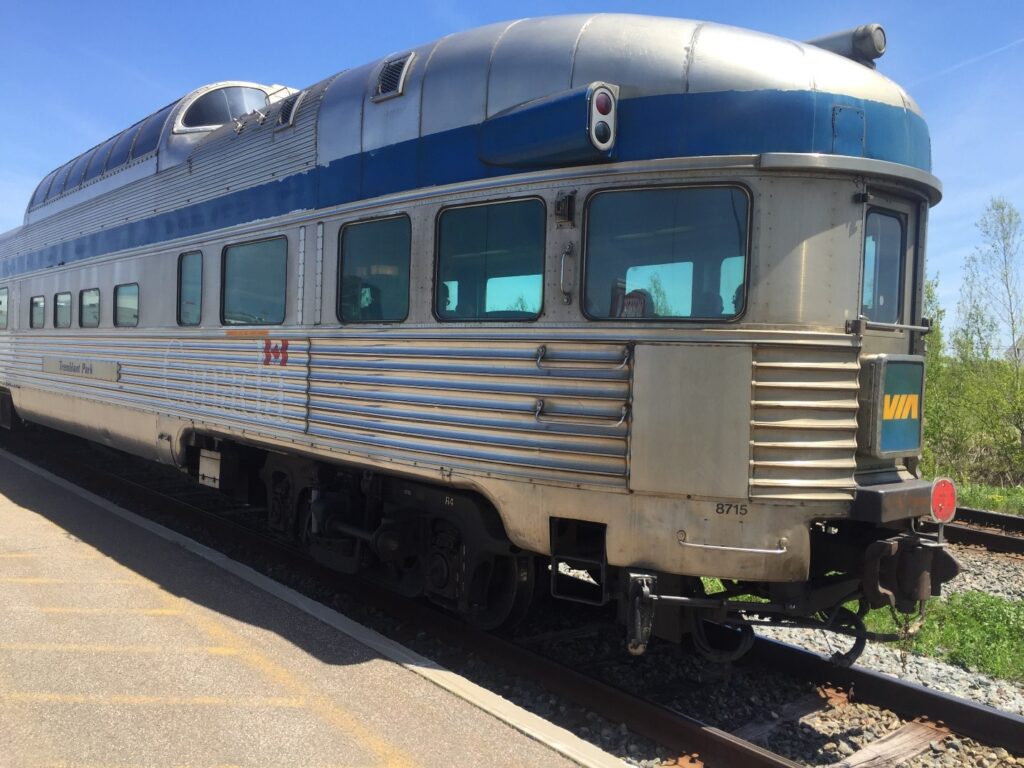
It’s been a long 17 months, but VIA Rail’s Ocean service is finally returning to the Maritimes – even if it won’t look quite the same as it did when the last train departed in March of 2020. VIA has just announced that the Ocean will resume its operations from Halifax on August 11, 2021, with a single weekly departure in each direction.
The first train will depart Halifax on August 11th, and the first eastbound trip will depart Montreal on August 15th; this will make for a schedule featuring Wednesday departures from Halifax and Sunday departures from Montreal, presumably following the same timetable as before the pandemic. VIA has labeled this a “gradual” resumption of service, and expressed optimism that additional frequencies will follow shortly; at the time of writing, an advisory on the VIA website shows tri-weekly service resuming in October, but this is always subject to change.
Consistent with trains like the Canadian that have been operating up to this point, the Ocean’s on board service offering will be much different during the first days of operation. Both Economy and Sleeper classes will be offered, in a mix of Renaissance and HEP1 stainless steel equipment, but passengers will not have free movement throughout the train. Sleeper passengers are asked to stick to their rooms for the duration of the trip, and Economy passengers to stay at their seats aside from trips to the washroom, or presumably stretch breaks at longer station stops. Passengers must wear masks on board, in keeping with federal requirements, except when eating or drinking or when in their own private rooms. Food service will be provided by cart to Economy passengers, and by room service to sleeper passengers – no meals in the dining car, for now. There will also be no lounge access for the time being, and while a Skyline dome may eventually be included in the consist, there won’t be one for the time being. As has been the case throughout the pandemic, all of these restrictions are subject to change as the situation evolves.
A special deadhead train will soon head east to ferry equipment from Montreal to Halifax to allow for crew training and the first departure from Halifax (*UPDATE: This deadhead train arrived in Halifax on the morning of July 13th). With the service shut down for such an extended period, quite a number of crew members have no doubt chosen to take retirement or have found other employment, so new on board crew training will be essential. Once this consist heads east, we should finally get a look at the new incarnation of the Ocean, now that the train cannot be turned. We expect to see a hybrid hodge-podge of Renaissance and HEP equipment, with baggage cars on both ends and no Park car, on account of the need to run the train in reverse for the return trip.
Regardless of the changes to the train, it is still a positive sign to see VIA’s return to the region, and TAA will continue to advocate for a full service resumption as soon as possible, and further improvements moving into the future.
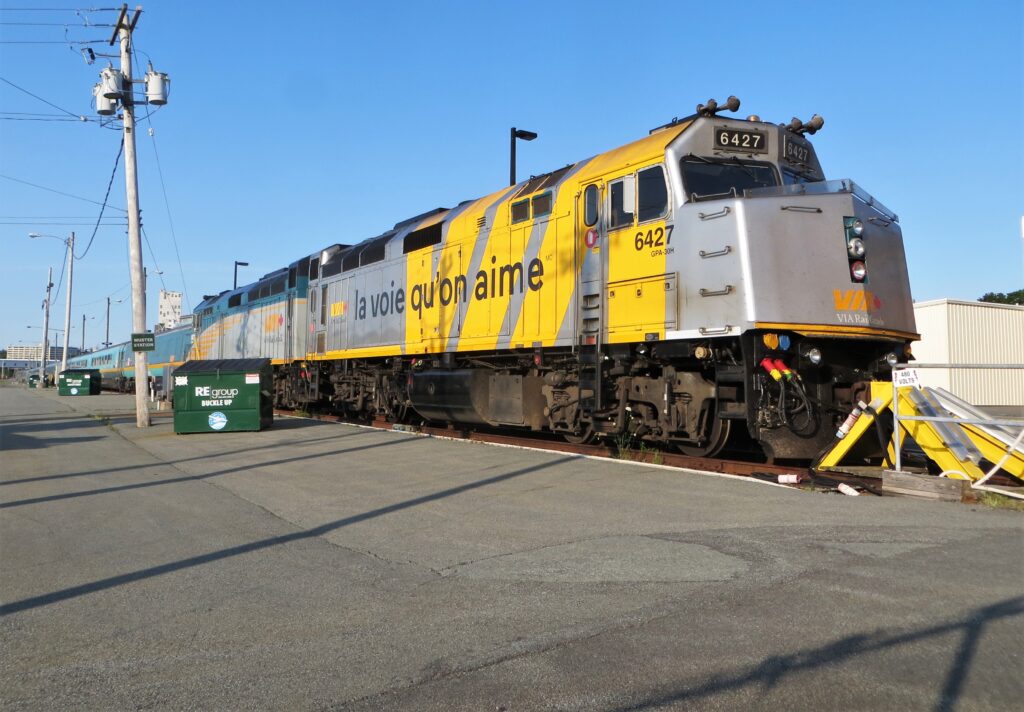
“OPEN WITH AN ASTERISK” – A DIFFERENT SUMMER AT MARINE ATLANTIC
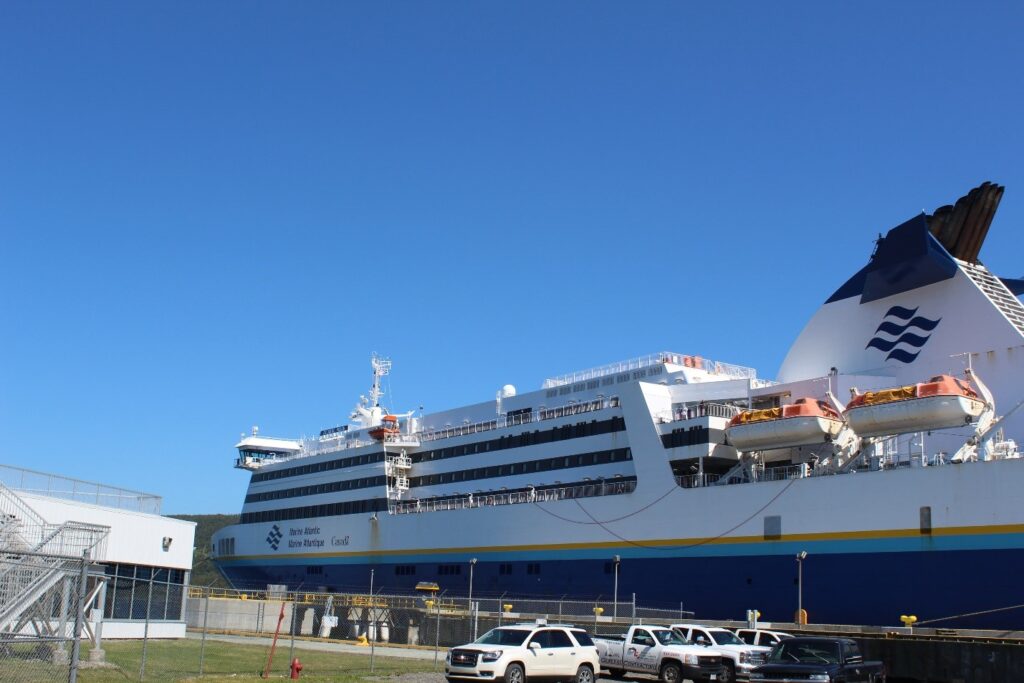
More than two weeks delayed from the originally planned date, MV Atlantic Vision docked at Argentia NL on the morning of July 5, marking the launch a scaled-down 2021 seasonal service. Although it is a significant improvement over 2020 when the route did not operate at all, the Vision will be sailing this summer under the dark cloud of COVID-19. Consequently, many of the onboard amenities that had helped make the trip a special travel experience in recent years won’t be offered. And, there will be only two weekly round trips instead of the usual three.
Colin Tibbo, Marine Atlantic’s chief information officer and acting vice-president of customer experience, says there is sufficient flexibility in their operational plan to allow for a third return crossing should demand exceed expectations. But for now the departures from North Sydney will be at 1730 ADT on Sunday and Wednesday only, sailing from Argentia at 1700 NDT on Monday and Thursday. To allow for social distancing there will be a limit of 300 passengers per crossing, which means much of the auto deck space will be empty. Most of the passengers are expected to be in cabin accommodation, and Mr. Tibbo notes that demand for private rooms is stronger than ever. In fact, he senses a trend where this is a make-or-break condition for many prospective customers. However, the good news for unberthed passengers in lounges is that they will be sufficiently spaced so that wearing of masks will not be required once they are seated.
The popular buffet dining option on the Vision has fallen victim to the pandemic – perhaps permanently – and the upscale dining room experience will also not be offered this year. The only alternative to the ship’s rather small snack bar will be a light meal service available in the bar lounge area.
Mr. Tibbo said the company did not want to cancel the Argentia run again this year, despite the pandemic uncertainty, because they consider it to be an important part of their summer service offering. He noted that, despite the limited amenities, the initial July 4 departure was booked to 98% of its reduced passenger capacity a few days prior to sailing, which attests to the popularity of the seasonal route. The online “rolling schedule” that now allows customers to reserve up to 16 months in advance shows a return to three weekly crossings in 2022.
A similar passenger limitation applies to the year-round North Sydney-Port aux Basques route, where there are a minimum of two daily sailings. Public health measures are likewise in effect, and passenger amenities have been reduced accordingly. Commercial drivers are now berthed in single-occupancy cabins, which places additional pressure on accommodations aboard the Blue Puttees and Highlanders. The volume of commercial traffic hasn’t been significantly affected during the pandemic, and passenger bookings as of early July were running between 30 and 40 percent higher than corresponding dates in 2020.
Customer expectations for Marine Atlantic appear to have adjusted somewhat because of COVID-19, just as they have elsewhere in the transportation and hospitality industries, but Mr. Tibbo expects they will become higher with the passage of time. He’s reluctant, however, to predict timelines for the return to a higher level of customer amenities.
“We’ll see how it unfolds,” he says, “For now, we’re open – with an asterisk!”
-Ted Bartlett
MARITIME BUS BEGINS SIX-DAY OPERATION; DRL SOLDIERS ON
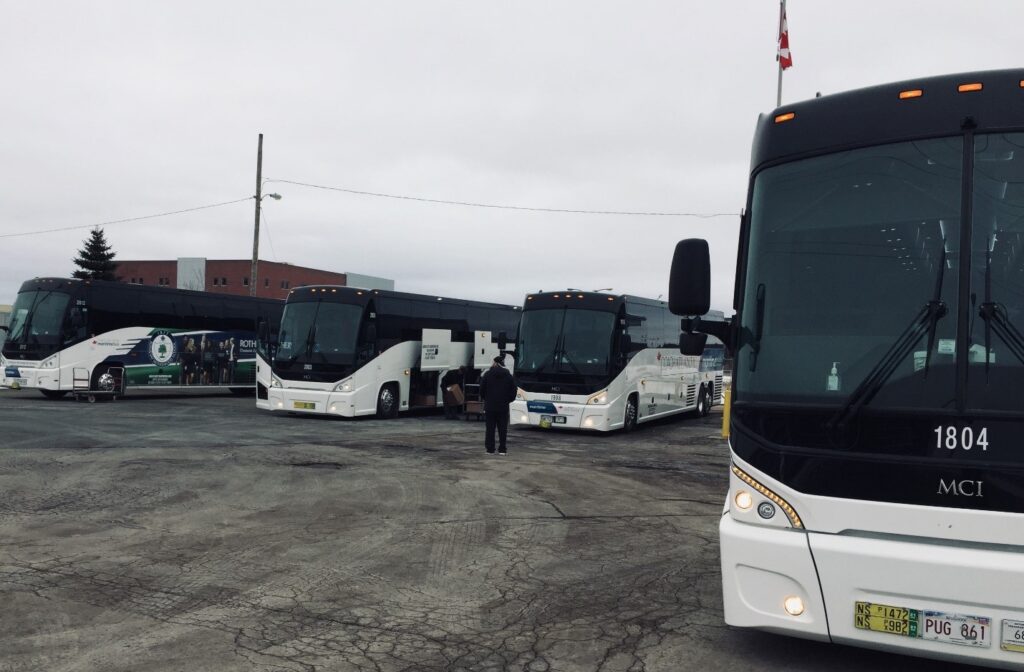
With the rejigged Atlantic Bubble now in effect, Maritime Bus owner Mike Cassidy is looking ahead to better days – but he finds it hard to be optimistic. In anticipation of increased travel, the company bumped its schedules up to six days a week effective June 23, but uptake has been very slow, with three different reopening plans in the Maritime provinces having a dampening effect on ridership.
There’s been no response to date to the industry’s urgent pleas for federal support and a modest financial commitment to help rebuild a national intercity motorcoach network in the wake of Greyhound’s complete abandonment of Canadian service and the devastation of COVID-19.
“It appears as if there is no champion at the federal or provincial level,” Mr. Cassidy commented. “All I can say is that busing in Canada needs help.”
Meanwhile in Newfoundland, the orange DRL coaches are still plying their 900 km. route, serving 25 stops along the Trans-Canada highway from St. John’s to Port aux Basques. This despite a warning from owner Jason Roberts last month that financial pressures might force the company to cease operations. There’s been no word on the possibility of any assistance from the cash-strapped provincial government, along the lines of emergency aid extended earlier this year to Maritime Bus by Nova Scotia, PEI, and (after some prodding) New Brunswick.
But unlike elsewhere in Canada, there appears to be some onus on Ottawa to support DRL, which acquired the trans-island bus service from newly-privatized Canadian National in 1997. The so-called “Roadcruiser Service” had replaced the CN passenger train in 1969, and federal government responsibility to ensure continuing service at fares consistent with passenger rail elsewhere in Canada was acknowledged in the 1988 federal-provincial Memorandum of Understanding that provided for final abandonment of the Newfoundland Railway. However, none of the province’s six Liberal MPs have as yet weighed in on the issue.
SHUTTERED AIRPORTS REOPEN – WITH SOME NEW SERVICES
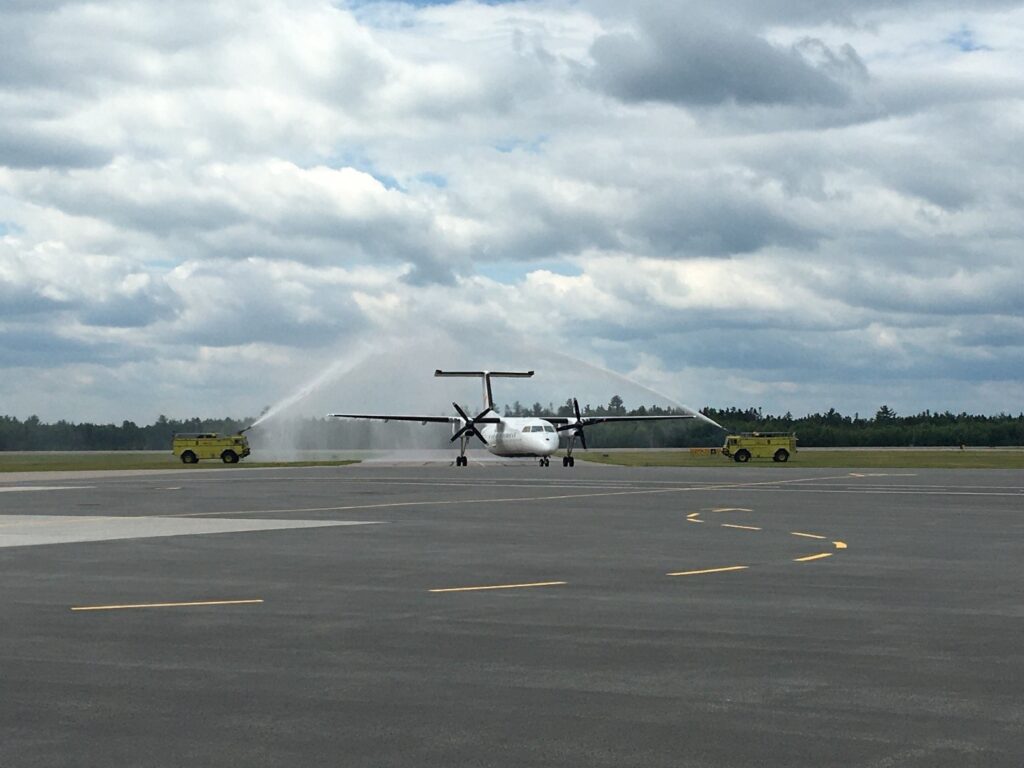
With the gradual lifting of COVID-19 restrictions, the aviation industry in Atlantic Canada is at last on final approach to what may prove to be a long period of recovery. Three regional airports in the Maritimes that had been completely devoid of scheduled passenger service for more than five months reopened for business in late June, and flight frequencies at others that had maintained limited service during the pandemic were noticeably increased. There were even some new destinations on departure boards around the region as airport spokespersons expressed cautious optimism.
Notable among recent developments was the return of scheduled service to Saint John, Fredericton and Sydney, which had been in hibernation since January. In addition to the return of Air Canada services to Toronto and Montreal, and WestJet flights to Toronto, YFC welcomed its first-ever direct service to and from Newfoundland with a tri-weekly flight by PAL Airlines to and from St. John’s with an intermediate stop at Deer Lake. In addition to the return of Air Canada service, discount carrier Flair Airlines was offering flights to Toronto from YSJ for as little as $49 one-way on a once-a-week 737 jet. At Sydney, WestJet resumed service to and from Halifax, while Air Canada was offering direct flights to Toronto.
St. John’s welcomed the return of direct service to Toronto by both Air Canada and WestJet, after an absence of several months. It would appear that Air Canada has no plans to resume local services between Halifax and various Maritime airports, but it looks like PAL is moving in to take up where the national carrier left off. PAL’s ambitious expansion plans also include offering service to Ottawa beginning in August. And by the time Porter Airlines returns to the skies in September, they may find the field a little bit crowded.
But make no mistake: air travel is by no means back to normal, or even approaching a new normal. The majority of the reinstated services are at greatly reduced frequencies – less than daily in many cases. Even the most optimistic air travel advocates will acknowledge that the road back will be a difficult one. Many restrictions remain in place, with most airports limiting access to their facilities strictly to passengers holding tickets. Most food and beverage concessions have not reopened, and masks must be worn continuously from entering the departure terminal until the exit on arrival.
There’s been no indication as to if or when overseas flights might return to Halifax Stanfield International Airport. For the foreseeable future, Atlantic Canadians destined to Europe or the UK will be obliged to fly several hours in the wrong direction before heading across the big pond.
NEW RURAL AND SMALL TOWN TRANSIT INITIATIVES UNDERWAY
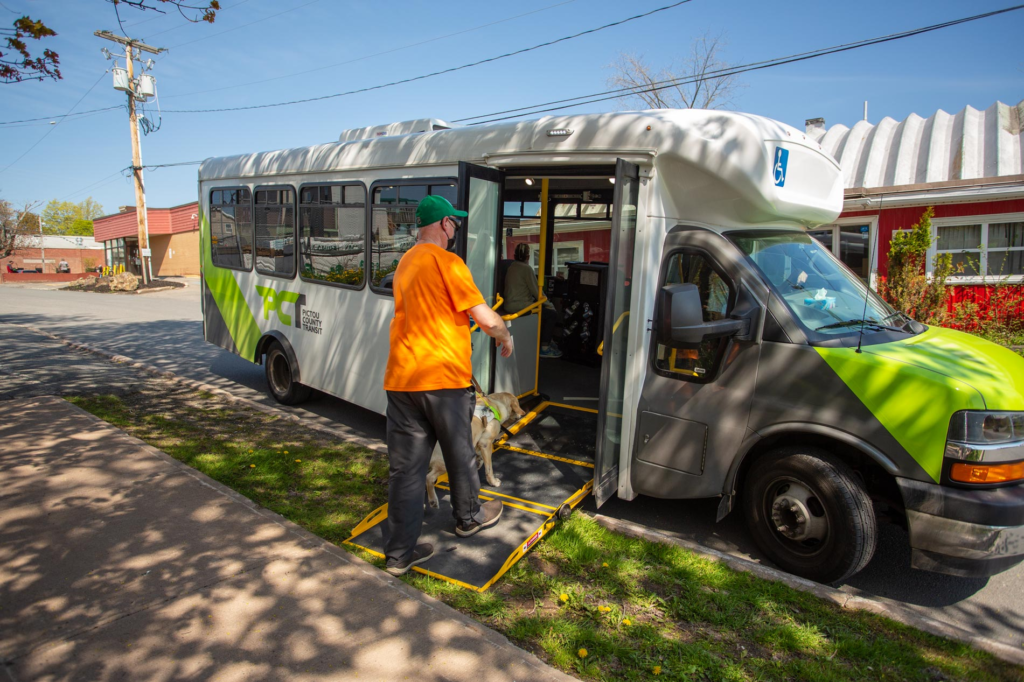
Residents of the Nova Scotia towns of New Glasgow and Stellarton are once again able to avail of public transit. Pictou County has not seen such a service since 1996, and the three-year pilot project should provide ample opportunity to prove that it is both needed and sustainable.
Ridership numbers will determine if the service continues past the three-year trial, and promoters emphasize it is very important the community support the service by using it.
The route is a one-hour bus loop through the two towns, but it’s been named Pictou County Transit in the hope that other communities will join in.
The new, fully accessible, one-door-for-all, low-floor bus made its inaugural run on May 17. The $190,000 capital cost was underwritten by the Province of Nova Scotia, which is also fully funding the first year of operations. Years two and three will see Stellarton and New Glasgow pay $50,000 and $100,000 annually, respectively.
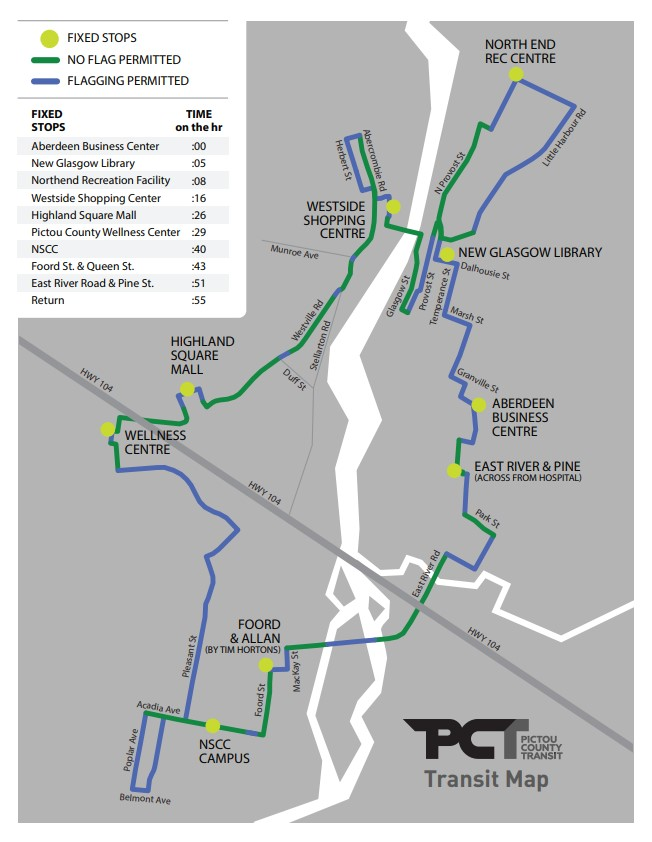
Meanwhile in New Brunswick, the community group Eastern Charlotte Waterways (ECW) has been awarded a rural transit pilot project grant by Environment and Climate Change Canada. The federal funding will provide a new ride-share transportation system to the community of Blacks Harbour and the southwest New Brunswick region.
A media release says that issues of mobility and accessibility in rural communities are well documented, and Blacks Harbour is no exception. This pilot project aims to address these transportation issues by providing a fleet of electric cars for community-wide use. It will act as an on-demand door-to-door service. The new rideshare system which will launch in the fall of 2021, is the natural next step in working towards designing sustainable systems for rural communities in Charlotte County.
“ECW’s mandate has always been supporting sustainable projects that benefit local residents and the environment,” says Rick MacMillan, the group’s chair. “This investment will improve accessibility and the livelihoods of people in our community while raising the profile of the village to attract new businesses, visitors, and residents. Providing this climate-friendly ride-share program helps facilitate the community’s potential growth through connectivity.”
Blacks Harbour and the greater southwestern New Brunswick region has not had a public transportation option since the end of the RuralLynx project in 2020. With federal support, ECW will be able to operate an integrated public transportation model, built upon eight years of extensive research and reports from the Southwest Transit Authority Board as well as other community organizations both in and outside the province of New Brunswick. The announcement notes that the ECW team will be working collaboratively with key community partners that include the Charlotte County Multicultural Association and Vibrant Communities Charlotte County to ensure the pilot project is successful in providing all community members with an efficient, affordable and climate-friendly way to get around. This rural transit pilot project is described as an investment in social infrastructure that prioritizes rural communities and facilitates future growth.
FARES REMOVED FROM NOVA SCOTIA PROVINCIAL FERRIES
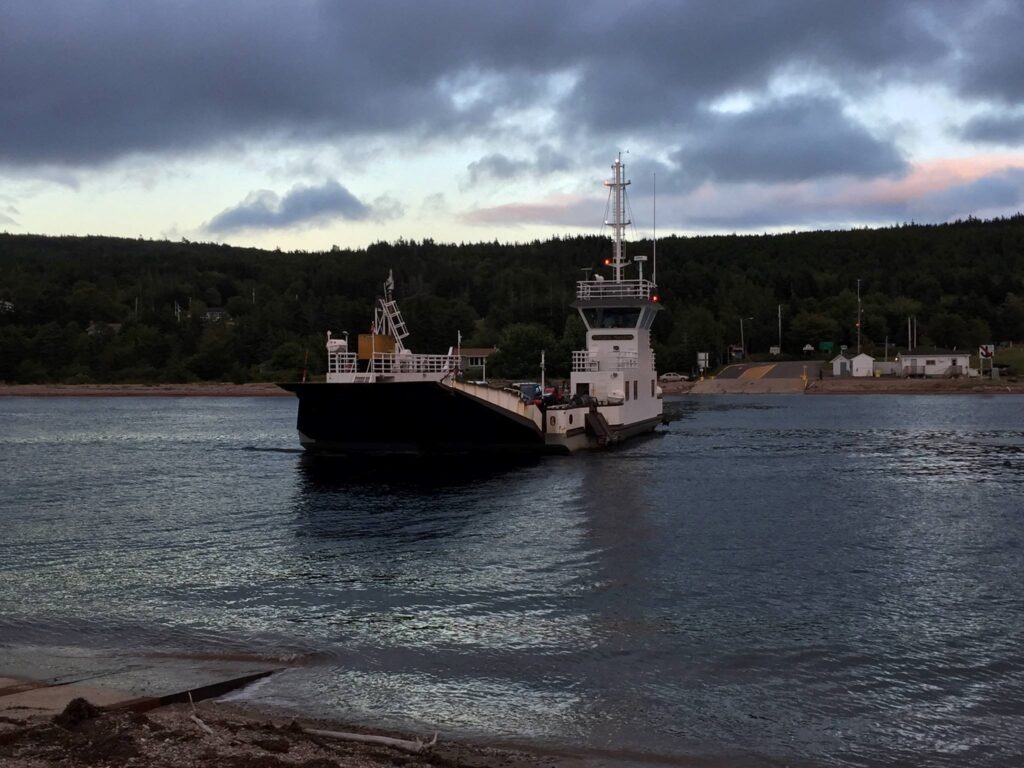
Drivers in Nova Scotia will no longer have to pay to use any of the province’s seven intra-provincial ferry services, as the provincial government announced the permanent removal of ferry fees in late June. The ferry services, operated by Nova Scotia’s Department of Transportation and Infrastructure Renewal, include those at Englishtown and Little Narrows in Cape Breton, Country Harbour on the Eastern Shore, Tancook and LaHave on the south shore, and Petit Passage and Grand Passage on Digby Neck.
When announcing the permanent removal of user fees, which had been waived in 2020 during the Covid-19 pandemic, Premier Iain Rankin said the change will make transportation more “affordable and accessible for Nova Scotians”. Transportation Minister Lloyd Hines noted that the fees only covered a small percentage of operating costs, and were inefficient to collect and becoming an increasing burden to administer.
The province hopes that the removal of fees will help to encourage tourism by making more parts of the province more easily accessible, though it’s likely no coincidence that a provincial election is expected in the coming months.
